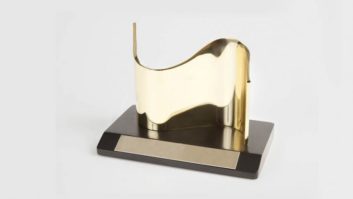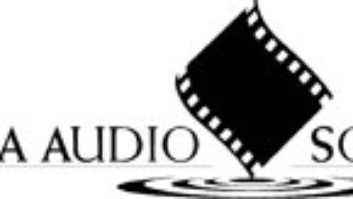A. Ancillary EquipmentAudio Precision System 2 Cascade: The next generation for AP’s industry-standard System Two series, Cascade provides approximately six times the DSP power and 10 times the FFT memory of the standard System Two. Features include improved converters, simultaneous acquire and transform of FFTs, signal acquisitions up to 5.4 seconds at 48 kHz, 8k to 200k sampling rate support, extended INTERVU’s jitter measurement down to 50 Hz, and saving AES/EBU interface signal waveforms to disk for later analysis. BSS Audio “Jellyfish” Soundweb 9010 Programmable Remote Control: This Soundweb accessory lets programmers provide a completely custom control environment to Soundweb systems. The hardware features six membrane switches, LCD menu screen, a rotary controller and a built-in paging mic. Features include: “nested” menus, multi-level security and control of digital audio routing. The remote is programmed via Soundweb Designer Software.
Lucid AD9624/DA9624 Converters: These stereo 24-bit, 96kHz converters for recording, mastering and post-production provide AES-3, S/PDIF, and TosLink digital interfaces. The AD9624 supports internally generated sample rates of 32, 44.1, 48, 88.2 and 96 kHz, as well as external word clock sync and 16-bit noise shaping for mastering applications. In addition to its main analog output, the DA9624 features a monitor output with independent volume control and front panel headphone jack.
Mark of the Unicorn MIDI Timepiece AV-USB: The MIDI Timepiece AV-USB is the flagship of MoTU’s new line of high-performance MIDI interfaces and synchronizers for Macintosh and Windows. All MoTU USB interfaces are equipped with MOTU’s MIDI Time Stamping[superscript]TM technology, providing sub-millisecond MIDI timing accuracy between the interface and the computer. Countless recording artists, engineers, producers, film composers, multimedia content developers, theme park designers and other entertainment industry pros rely on the MIDI Timepiece every day.
Neutrik Speakon NL2 2-Pole Connectors: The new 2-Pole Speakon[superscript]TM connection system offers a two-conductor alternative to the industry-standard 4-pole version, while maintaining compatibility between the NL2FC cable end and the NL4MP receptacle by picking up pins 1+ and 1-. The 2-Pole series complies with European safety regulations requiring electrically touchproof connectors and carries the UL and CSA symbols.
TerraSonde Audio Toolbox2: The Audio Toolbox2 is a portable, DSP-powered, multifunction, test, measurement and acoustic analysis device. Functions include: acoustic analysis: SPL, RTA, energy-time graph, RT60, and speaker polarity; test functions: signal generator, dB level meter, VU/PPM meter, frequency counter, signal/noise ratio, impedance/THD tests, sweeps and audio sample scope; timecode reader/generator/analyzer; MIDI analyzer/generator; headphone monitor amplifier (including guitar effects); instrument tuner; tempo analyzer and metronome; hum cancellation; and cable tester.
B. Amplifier TechnologyBryston 14B Pro: The Bryston 14B is a high-quality stereo amplifier delivering 500 watts per channel into 8 ohms and 800 watts into 4 ohms. THD is below 0.007% from 20 to 20k Hz. Noise is -106 dB below full output.
C-Audio Pulse Series: C Audio’s Pulse range incorporates the latest developments in lightweight amp technology and features advances in power supply design to compensate for thermal sag for high sonic integrity. The Pulse range uses a separate PSU to power the microprocessor-controlled section of the amp to warrant correct status control and monitoring when on-line with the CoNNECT II network. Units are available in 4×300, 2×650 and 2×1,100 watts/channel into 4 ohms.
Hafler SR Series: Hafler’s SR Series live sound amplifiers deliver continuous real power without thermal problems at any impedance. These two-rackspace amps are a new Class-G circuitry based around Hafler’s patented Transonova platform, providing a simple gain path for quality sound, high efficiency and low heat. Features include switching power supplies, surface mount components and MoSFET technology.
Pass Labs X5: The X5 5-channel amplifier uses the Supersymmetry circuit topology that improves the performance of a balanced amplifier by using feedback to improve the matching of the two balanced halfs. The amplifier uses ultra-matched components in a simple balanced circuit. The X5 accepts both single-ended and balanced inputs. The X5 is rated at 125 watts per channel into 8 ohms, all five channels driven.
QSC Powerlight 2: Designed for live sound/touring applications, the PowerLight 2 combines high-performance power with integrated signal processing. Four models deliver up to 1,850 watts/ch (2 ohms) in a 21-pound, 2U chassis. Each model is available in three versions-a standard base model, an “A” version with internal analog signal processing, and a planned “D” version with complete digital signal processing capability. Includes PowerWave[superscript]TM technology and DataPort for computer control.
Yamaha XM 4220: Dedicated to the needs of the sound reinforcement and contractor markets, the XM4220 is a multichannel power amp in a three-rackspace unit. Ideal for multi-zone applications and the high frequencies of bi- or tri-amp speaker clusters, the XM4220 channels can be bridged to provide increased power. Combining channels and offering 70-volt system operation, a single amplifier can run at 70-volt as well as 4 and 8 ohms at one time.
C. Mic Preamplifier TechnologyAphex Model 1100: A 2-channel tube preamp with onboard A/Ds , the Model 1100 offers more gain with no pain. EIN of -135dBu with 65dB of gain adds less than 1dB of noise to a typical mic. 20dB of additional headroom is provided by MicLim, a limiter on the output of the mic before the preamp, and LoCaf, a tunable low-cut servo filter. Gain can be cranked without the pain of noise or overload distortion. dbx 386: The 386 is the world’s first professional tube mic pre with dbx’s proprietary Type IV[superscript]TM conversion using the latest A/D converters and up to 96kHz sampling. The 386 also offers features such as dbx proprietary TSE[superscript]TM technology, AES/EBU and S/PDIF digital outputs, selectable dithering and noise shaping, and XLR and 1/4-inch analog I/o. These features make the 386 ideal for any analog or digital recording application.
Grace Designs Model 801R: The 801R is a digitally remote-controllable version of the acclaimed Model 801 8-channel preamp. Up to eight 801Rs (64 channels) can be controlled from up to 1,000 feet away by a single dedicated desktop remote. A large LCD displays channel status and metering; a pushbutton encoder offers instant access to parameters such as gain, phase reverse, phantom power, mute, etc.
Millennia Media HV-3D: Designed for critical applications requiring dynamic uniformity and timbre purity-such as large orchestra and effects recording-the HV-3 offers solid, consistent performance with complex source material and extreme dynamic levels. More than 100 channels of HV-3D selected for Barbra Streisand’s Y2K New Year’s gala concert. Used by a “who’s who” in classical music, acoustic jazz, film scoring and SR applications.
PreSonus MP20: This 2-channel mic preamp features high-quality audio transformers, dual servo gain stage, twin-FET Class-A discrete input buffers and a Left/Right summing bus for realistic stereo imaging. Servo balanced inserts support use of external processing, and the front panel provides a 1/4-inch instrument input, a high-output headphone monitoring jack and a Proprietery IDSS control that adjusts harmonic distortion for tube circuit emulation.
Summit MPE-200: The MPE-200 is a dual-channel Class-A solid state preamp/4-band parametric EQ with a transformerless signal path designed by Mr. Rupert Neve. All functions are digitally controllable from the front panel, through MIDI, via another Element 78 product, or with Pro Tools via Extension 78 plug-in software. Features include 25 onboard presets, automation and storage via MIDI, linking of up to 32 channels with a single front panel and remote control.
D. Computer Software & PeripheralsBIAS Peak 2.0: Peak 2.0, the upgraded version of this award-winning Macintosh-based waveform editing program, offers advanced features for professional recording, editing, processing and delivery; a TDM Edition, which includes all of Peak 2.0’s features plus TDM support, is also available.
Cakewalk Pro Audio 9: This multitrack digital audio and MIDI software for professionals features 24-bit/ 96kHz audio, real-time effects processing, real-time MIDI FX plug-ins, and a suite of professional editing and mixing tools, along with optimized audio performance for Windows 95/NT, support for MP3 and Windows Media Technologies, a new Session Drummer MIDI plug-in and support for AudioX hard-ware.
Minnetonka Mx51 v2.0: This dedicated software for surround sound mixing, takes the user from raw tracks to creating the final 5.1 surround master, using Minnetonka’s innovative build-your-own-mixer archi-tecture for easy creation of custom surround mixes. Mx51 has an integrated interface to optional Dolby and DTS surround sound encoders and interfaces to a force-feedback joystick so users can feel surround as they hear it.
MoTU Digital Performer 2.61: Digital Performer is the first and only audio sequencer to achieve both sample-accurate digital audio editing and sub-millisecond MIDI timing accuracy, thanks to Version 2.61’s unique MIDI Time Stamping technology. Digital Performer 2.61MTS also delivers the highest timingprecision ever offered by a sequencer with adjustable PPQ resolution, letting users work with MIDI data at any resolution, down to one one-hundred millionth of a quarter note.
Sonic Foundry Vegas Pro: Vegas Pro is a Windows-based, nonlinear, multitrack hard-disk recording sys-tem. Its unique multi-threaded architecture is designedto squeeze superior performance from standard PCs. Vegas Pro uses multiple processors, extra RAM and optimized disk throughput to achieve optimal multi-track performance. Audio data is processed using floating-point math precision, which-coupled with the ability to output 24-bit audio at the final mixing stage-results in superb audio fidelity. TC Works Spark: Spark, a 24/96 real-time Digital
Audio Mastering Editor for MacoS, is VST plug-in compatible and includes 12 TC Works plug-ins plus support for popular samplers, AIFF, QuickTime, SD2 and .WAV file formats. Spark’s Master View plug-in matrix can operate as a plug in within the MoTU MAS or VST environments, and CD burning software is included. A TDM version and Modular Synth plug-in option are available.
E. Microphone TechnologyAKG C3000B: AKG’s C3000B is a 1-inch large-diaphragm side address condenser mic designed to provide wide dynamic range and low self-noise. Features include a -10dB pad and bass rolloff filter. Internal shock mounting is provided along with a rugged external shock mount (H100). The C3000B’s sound quality remains consistent with AKG’s fine 52-year lineage. Specifications are: self-noise: 14dB; max SPL: 150dB; and dynamic range of 126dB.
Audio-Technica AT4047/SV: The large-diaphragm AT4047/SV capacitor mic is designed to provide the warm sonic characteristics reminiscent of early F.E.T.studio mic designs. Wide dynamic range, high SPL capability and exceptionally low self-noise combine in a versatile tool that’s ideal in digital recording environments, critical broadcast applications and live sound.
Earthworks SR77: The SR77 delivers a natural, time-coherent representation of sounds as they arrive at the mic, maintaining most of the “being there” quality of Earthworks’ omnis. on-axis frequency response is flat from 30 Hz to 30 kHz. Sonic timbre stays uniform across the entire front hemisphere, while off-axis rejection is thorough and uncolored. From quiet whispers to 145dB SPLs, the SR77 captures the sound of the source without coloration.
Neumann KMS 105: Proven condenser capsule technology and state-of-the-art transformerless electronics combine to create the KMS 105 handheld performancemic. With an innovative wire basket structure, shock-mounted circuitry and studio-grade specifications, the KMS 105 is designed for demanding stage performers. Wide dynamic range and extended frequency response make this microphone a natural fit for precision sound reinforcement systems and in-ear stage monitoring.
Soundelux U99: offering warmth and clarity, the Soundelux U99 brings the sonic glory of yesterday to today’s engineer. With its classic tube and transformer design, the U99 features a handmade European 1-inch diameter dual backplate, dual-membrane capsule, providing high headroom, low noise and wide bandwidth.
SPL Atmos 5.1 System: This package combines Dirk Brauner mic elements in the ASM5 array with the hand-built SPL Atmos 5.1 mixer. The system sets up in minutes to create discrete 5.1 recordings of the highest possible fidelity. Features include triple-stage preamps with motorized gain controls, front/surround matrix with LCR panning and divergence controls, sub bass generation matrix, remote pattern control for each mic and discrete 6-channel outputs compatible with all formats from DVD to SACD.
F. Sound Reinforcement Loudspeaker TechnologyAudio Composite Engineering 1160WR: This advanced, cored carbon fiber enclosure composite loudspeaker is designed for applications requiring wide-dispersion, high-output distributed sound. Its compact size, wide dispersion pattern and high SPL capabilities make this system ideal for large-format under-balcony use, as well as other background/foreground reinforcement applications.
L-Acoustics DV-DoSC: This active, 2-way, vertically arrayable enclosure uses two 8-inch cone drivers and a 1.4-inch compression driver mounted on the proprietary DoSC waveguide in an extremely compact for-mat for fixed installs, touring, theatrical and nightclub use. DV-DoSC array bandwidth is 100-18k Hz (+/-3dB), with 120Degrees horizontal coverage and all the advantages of L-Acoustics’ Wavefront Sculpture Technology[superscript]TM, including perfect coupling and a coherent wavefront from a small (70.2 pounds) enclosure.
Mackie SRM450: Delivering accuracy and performance in an easily portable and affordable loud-speaker, the SRM450 active sound reinforcement loudspeaker brings truckloads of power to any event, eliminating the need for external amplification and costly electronics (such as processors). The SRM450-the first in a series of speakers developed with RCF, which has 50 years of speaker experience-uses technology and features found in systems costing thousands of dollars.
Martin Audio WT3: This innovative system achieves true 3-way performance from an enclosure only 28 inches high. It features a powerful 15-inch bass driver, a 6.5-inch cone midrange horn and a 1-inch exit HF with with matching 65x40Degrees dispersion characteristics. The 6.5-inch midrange horn was developed to overcome the power and distortion limitations of traditional large-format compression drivers, allowing the WT3 to produce extremely high sound levels without distress.
Meyer Sound UPM-1P: This compact, self-powered, bi-amped, 3-way design incorporates dual 5-inch low/mid transducers, a 1-inch HF driver on a symmetrical 100Degrees horn, a 2-channel power amp and proprietary phase-corrected active processing. Ideal for applications requiring high SPLs, low distortion and uniform directional control, such as vocal range reinforcement as a small P.A. system, under-balcony or front/sidefill use, or as a full-range system with an optional subwoofer.
Shure PSM700 Personal Stereo Monitor: This in-ear monitor system combines quality sound and wireless frequency agility, enabling musicians to hear themselves clearly and safely, without floor wedges. Features include Dynamic overload Protection and several universal-fit earphone options, including the acclaimed dual-driver Model E5. With 32 selectable UHF frequencies (16 simultaneous) and the choice of stereo, mono, or MixMode[superscript]TM operation, the PSM 700 affords users new levels of freedom, fidelity, and personal control.
G. Studio Monitor TechnologyGenelec 1036A: Genelec’s flagship 1036A goes lower in frequency than any other Genelec monitoring system. Each channel consists of a 430-liter speaker enclosure and an electronics rack, containing active crossovers, and LF/MF/HF amps delivering 2×1,100, 600, and 300 watts of short-term power. Twin 18-inch woofers reproduce frequencies to 19 Hz (-3dB). Dual 5-inch Genelec midrange and a single 1-inch compression tweeter extend the frequency response to 22kHz.
JBL LSR25P: The JBL LSR25P is a compact bi-amplified monitoring system with a 5.25-inch woofer and 1-inch titanium composite tweeter with 100 watts for lows and 50 watts for high frequencies. The aluminum enclosure incorporates an EoS waveguide and Linear Dynamic Apertures. The LSR25Ps combine JBL’s latest in transducer and system technology and incorporate the LSR design philosophies. The LSR25P provides an accurate reference for workstations, edit suites and small control rooms.
Klein & Hummel 0198: A compact, active 3-way monitor delivering extremely low coloration and distortion, the 0198 employs integrated waveguides to deliver a wider and more constant “sweet spot” than other compact monitors. Features include a 1-inch tweeter/waveguide, a 3-inch dome mid and a fast, low-mass 8-inch woofer in a sealed, mag-shielded enclosure. Designed for the pro who spends long days listening.
KRK V-6: This compact, powered system features separate amplifiers for the woofer and tweeter, active electronic crossover and internal magnetic shielding.Drivers are a 6.75-inch polyvinyl woofer and a 1-inch silk dome tweeter. Frequency response is 54 to 20k Hz +/-2 dB. Maximum SPL at 1 meter is 102dB music,105dB peak.
M&K Professional MPS-2510/P, Based on the critically acclaimed MPS-2510, the MPS-2510/P uses the same woofer and tweeters, with an Active Phase-Focusedcrossover, and dual 150-watt amps in a slightly larger cabinet. User-selectable vertical directivity allows for optimization in various monitoring environments. Five MPS-2510/P monitors, along with an M&K Pro subwoofer, create a 5.1 music mon-toring system, providing the reference level playback required by Dolby and THX.
Tannoy Proto-J: This monitor combines a detailed, dynamic sound with a wide, flat frequency response. A 3/4-inch soft-dome HF unit is matched to a 6.5-inch, long-throw bass unit in a vented enclosure with a chamfered front-baffle to reduce HF diffraction effects. Integral inserts accommodate omniMount[superscript]TM 50 Series wall brackets for flexible 5.1 surround sound installs. Tannoy’s optional PS110B subwoofer completes the package.
H. Musical Instrument TechnologyAkai MPC 2000XL: The Akai MPC 2000XL is everything you would expect from an MPC and more. New creative tools include dedicated buttons for selected features. Next Sequence key, four bank keys, and Track Mute key provide instant access for recording and live performance. A hinged LCD, 32 voices, up to 32MB of RAM, multi-program playback, device naming, MIDI soft thru, multitrack recording, time stretch, and resampling take the MPC 2000XL to the next level.
Alesis DM Pro Drum Module: The DM Pro Expandable 20-Bit MIDI Drum Module features: 64-voice polyphony; more than 1,000 drum and percussion sounds; 16 trigger inputs for electronic pads, tape replacement or triggering acoustic drums; six independent audio outs; storage of 32 virtual drum kits; PCMCIA-format cards storing up to 8MB; and onboard multieffects using the same processing engine as Alesis’s top-of-the-line Q20.
E-mu Proteus 2000: This 128-voice MIDI sound module features 32 MB of resident RoM sounds (with room for 96 MB more), along with four real-time front panel controls, 6-pole dynamic filters, onboard dual 24-bit effects, six analog outputs and S/PDIF digital output-all in a single-rackspace package.
Korg Triton proX: This 88-key music workstation offers Korg’s HI Synthesis System, a full-featured integrated stereo/mono sampler, onboard sequencer and arpeggiator, along with six audio out-puts and 838 high-quality PCM sounds. Its 16 MB of sampling RAM (nearly 3 minutes mono @ 48 kHz) can be expanded via standard 72-pin SIMMs, and the sys-tem reads stereo/mono AIFF files, Windows .WAV files, Akai S1000/S3000 (floppy or CD-RoM) and Trinity -format data.
Kurzweil K2600: Available in 88-note weighted keyboard, 76-note or rack versions, this synthesizer/sampler has 495 programs, state-of-the-art sounds, effects, a flexible architecture, eight analog balanced (or unbalanced) outputs and dual SCSI connectors. A sample option provides a 20-bit digital output and allows external analog or digital stereo signals to be processed. Reads most popular sample formats. RAM is expandable to 128 MB via 72-pin SIMMs. Yamaha S80: Featuring an 88-note, weighted piano keyboard action combined with a high-quality, expandable synthesis engine, the S80 makes a perfect con-troller/ synthesizer for the heart of a complex MIDI system. For the ultimate in expansion capability, the S80 has two plug-in expansion slots, which allow the unit to hold any two boards from Yamaha’s extensive PLG line of Modular Synthesis plug-in expansion boards.
I. Signal Processing Technology/HardwareAvalon Design VT-747SP: The VT-747SP is a Class-A, 100% discrete, stereo spectral opto-compressor with passive 6-band graphic EQ and built-in 2-band parametric sidechain. The VT-747SP features TSP, enabling the choice of three dual triodes in the signal path for warm tube tone, or all-discrete Class A-transistor amps for classic opto-compression. The VT-747SP is perfect for DAW input signal conditioning, stereo bus compres-sion/ EQ, stereo keyboards and mastering applications.
Eventide orville: With up to eight times the power of Eventide’s legendary DSP4000 Series, and up to eight simultaneous channels (four AES/EBU digital and four analog), orville is ideal for digital TV and film post-production, surround sound and music recording. Its dual-engine, 24-bit/96kHz configuration, anything-to-any-thing routing and onboard 174-second sampler, allows new effects such as UltraShifter formant-correct pitch shifting and FourSidedVerb multichannel reverb.
Lexicon MPX 500: A true stereo 24-bit, dual-channel processor with balanced analog and S/PDIF digital I/o, the MPX 500 has 240 presets with classic, true stereo reverb programs such as Ambience, Plate, Chamber and Inverse, as well as Tremolo, Rotary, Chorus, Flange, Pitch, Detune, 5.5-second Delay and Echo. Dual-channel processing allows control of completely independent effects on the left and right channels.
Sony DRE-S777 Sampling Digital Reverb: The DRE-S777 24-bit sampling reverberator uses Real Impulse Response reverberation algorithms, based on actual acoustic spaces or re-creations of classic plate rever-berators, which can then be optimized for low-noise performance. out of the box, the DRE-S777 supports mono in, stereo output and a 48kHz sampling rate. Sony’s optional DABK-S703 expansion DSP board, adds 2-in/2-out stereo (up to 96kHz sampling rate) or 4-channel surround operation.
TC Electronic System 6000: TC’s flagship multichannel audio signal processing mainframe is targeted toward music film/post-production, broadcast and mastering applications in surround or multichannel environments. In addition to natural 5.1 reverbs, room simulations, special effects and vintage algorithms, surround multi-band dynamics “Finalizer” processing and pitch are also available as part of the System 6000’s comprehensive processing palette-all available through the touch of a screen over a powerful routing matrix.
Waves L2: Based on Waves L1 software, the most popular digital limiter in the world, Waves’ L2 adds 48-bit resolution, 96kHz support, ninth-order noise shaping IDR (increased digital resolution) dithering, 24-bit/ 96 kHz AD/DA converters and the world’s cleanest brickwall limiter.
J. Signal Processing Technology/SoftwareAntares Microphone Modeler (AMM-1): Using Spectral Shaping Tool[superscript]TM technology, Antares created precise digital models of a wide variety of mics, from historic classics to modern industry-standard work-horses. The user enters the microphone being used and what mic it should sound like. The AMM-1 references the stored models of source and target mics and processes the input to sound like the desired mic; other factors, such as mic distance, bass rolloff and tube satutration, can be added.
Bomb Factory Classic Compressors: Classic Compressors plug-ins look, sound and work just like the real thing, with meticulously crafted digital versions of the LA-2A and 1176, the most popular vintage compressors used in top pro studios. Proprietary modeling technology captures every tube, transformer and transistor of the originals! Plus Classic Compressors offer sidechain support and perfect stereo tracking-two features not available in the “vintage”domain.
Cycling ’74 Pluggo: Pluggo is a collection of over 74 plug-ins for VST or MAS sequencing or audio editing applications. In addition to a continuum of normal to outrageous plug-ins, Pluggo includes audio routing, tempo-synchronized parameter sequencing and modulation, virtual MIDI instruments and controllers, and the ability to host and modulate any VST plug-in- even in MAS.
Kind of Loud Technologies RealVerb 5.1: A Pro Tools TDM plug-in, RealVerb 5.1 multichannel reverb features physical modeling and auralization technology to add depth and dimension to recordings. The ability to control parameters with precision, create custom rooms with control over material, thickness, dimension, shape and size and to change these controls in real-time sets RealVerb apart. To this, RealVerb 5.1 adds the ability to place reverb elements individually in a 360Degrees soundfield.
Serato Pitch ‘n Time[superscript]TM: This Audiosuite plug-in for Pro Tools features an algorithm that time stretches and pitch shifts audio with quality, regardless of the source material, whether it be music, speech, ambience or sound effects. Pitch ‘n Time can pitch shift up or down 12 semitones and simultaneously time stretch from 50% to 200%, all without having to adjust non-intuitive parameters.
Waves C4 Multiband Parametric Processor: Designed for the Pro Tools 24|MIX system, the C4 Multiband Parametric Processor uses the compression design from the TEC-nominated Renaissance Compressor[superscript]TM including ARC[superscript]TM, Electro and opto bands. Features include a transparent crossover design with global-adjustable Q; true parametric control with independent threshold, range, gain, attack, release and bandwidth per band, and compression, expansion or EQ independent of the functions of the other bands.
K. Recording Devices/Storage TechnologyAkai DPS-16: The DPS-16 has introduced the masses to the 24-bit/96kHz recording world. This 24-bit/ 96kHz 16-track digital personal studio features a 6-inch diagonal flip-up graphic display, 10GB internal IDE drive, 56-bit 4-channel effects processor, 24-bit/ 96kHz AD/DA converters, and no data compression. Akai’s Q-Link Navigation includes real-time control knobs, providing an easy-to-use operating system.
360 Systems TCR-8: The TCR-8 is an 8-track synchronous master recorder offering 24-bit audio quality, several storage options, complete timecode implementation and VTR emulation. Providing a 20dB SNR and dynamic range improvement over conventional designs, TCR-8 is the only recorder available that offers Bit-For-Bit[superscript]TM reproduction of 24-bit PCM, Dolby-E and AC-3 recordings. Recordings can be stored on internal hard disks, 250MB Zip disks or its onboard DVD-RAM drive.
Alesis MasterLink ML-9600: This mixdown and mastering system combines hard disk recording and editing,digital signal processing and CD creation in a single versatile unit. MasterLink stores, delivers and plays stereo 24-bit, 96kHz audio on standard CD-R blanks. Masterlink can also create conventional 16-bit, 44.1kHz Red Book format CDs. MasterLink features an internal hard drive with editing, digital signal processing and mastering functions, a 4x CD-R drive and 24-bit converters.
Glyph Technologies Coba/SAN: Coba/SAN enables audio pros to work in closer collaboration with others. Coba/SAN’s primary component is the Coba control unit, which includes up to six Fibre channel connections bridged to Ultra SCSI/LVD drives. Each Coba enables as many as six users to share eight (up to 256) high-performance SCSI drives at speeds as high as 100MB/sec.
Roland VSR-880: The VSR-880 is an 8-track recorder with 128 Virtual Tracks in a standalone rackmount package. Like all V-Studios, it features nondestructive editing with 999 levels of Undo, Cut/Copy/Paste/Exchange editing using the backlit LCD, Preview and Scrub functions, and various 24-bit I/o choices. An optional DSP board adds two powerful onboard stereo effects processors, with compressors, reverbs, guitar amp modeling and mastering algorithms.
Tascam DA-78HR: offering a choice of 24- or 16-bit recording/playback, the DA-78HR DTRS-format modular 8-track tape recorder is compatible with all DA-98, DA-88 and DA-38 tapes. An onboard 8×2 MIDI-compatible mixer offers volume and pan control of all eight tracks. Mixes can be routed to two tracks of the existing tape (due to the built-in read-before-write function) or to any digital device with an S/PDIF interface. Sixteen units can be stacked for up to 128 tracks.
L. Workstation TechnologyAMS Neve AudioFile SC: This 32-track audio editor features a performance accelerator that boosts operational speed up to 50 times faster than previous-generation editors. Featuring both a proprietary audio processing engine and Windows NT technology, AudioFile SC provides unrivaled edit power plus industry-standard connectivity. The system also offers a range of WorkFlow[superscript]TM tools for increasing project throughput in a facility.
Digidesign Pro Tools 5.0: Pro Tools 5.0 provides new functionality for entry-level as well as professional music and post-production on the Mac and Windows NT platforms. New post functions include advanced editing features and native support for capturing, importing and playback of Avid media within Pro Tools. other features include an updated plug-in architecture, integrated MIDI sequencing and the introduction of cost-effective host-based mixing and processing systems for project studios.
Fairlight FAME 2: Combining up to a 48-track hard disk recorder, digital audio workstation with full graphical editing and a totally automated digital mixer, FAME 2 offers seamless random access operation with an intuitive, fast and responsive interface. Features include 48 processing channels (expand-able to 64), 24-track recorder/editor with 24 output buses, 24-bit resolution and 32 to 48kHz operation (96kHz sample rate-ready).
Soundscape R.Ed: This Windows 95/98/NT-compatible 32-track recorder/editor offers sample rates up to 96 kHz, and maximum 137GB storage using IDE drives. Features include 24 digital I/os (via TDIF), and control via RS-422, timecode and MIDI.
Spectral Design Audio Cube3 II: This NT-based, 24-bit/ 96kHz mastering/audio restoration / archival /editing workstation features 64/32-bit floating point Native Signal Processing and a powerful, fully integrated editor. It performs over 20 real-time restoration/mastering functions, including de-buzz, de-noise, de-ess, de-clip, de-scratch, azimuth correction, loudness maximizing, simulation of analog EQ and analog tape machine saturation, and phase linear EQ with sound morphing.
Waveframe 408+: With its intuitive user interface and real time editing capabilities, the 408+ offers power and speed for recording/editing dialog, Foley, ADR or music production. The 408+ includes applications for spotting ADR and Foley with beep output and GPIs to trigger wipe generators, while its Cue Sheet program prints stage-ready cue sheets, generated from your edits. Sync capabilities include LTC, VITC, 422TC, composite video and word clock at any frame/sample rate, forward and backward.
M. Sound Reinforcement Console TechnologyAudio Toys Inc. Paragon II Monitor: This automation-ready console features the ATI compressor, gate circuitry and 4-band parametric EQ on each channel with multiple solo buses, insert points and extensive metering that’s ideal for in-ear and/or wedge monitor mixing. Paragon II’s capability to generate up to 32 mono or 16 stereo monitor mixes, while still having two mix bus, two stereo aux sends and two direct outs from each channel, gives monitor engineers a new level of operating flexibility.
Crest X-Monitor: The X-Monitor offers 12 discrete mixed outputs (all with parametric EQ) that are individually or globally switchable to stereo mode to suit traditional monitoring or the increasingly requested in-ear systems. Inputs can be routed to special outputs for up to 18 output mixes. Microprocessor-controlled muting is standard, as is a full meter bridge and a built-in splitter system on all inputs.
InnovaSoN Sensory Grand Live: Combining full digital snapshot recall/reset capability, the Grand Live maintains an analog feel with motorized faders, knobs and switches, plus an easy-to-use 63-bar graphic display, channel-to-channel copying and offline editing-with automation software for theater use. Features include 72 inputs, 48 input faders and 24 mix buses-all with independent compressor, noise gate and 4-band parametric EQ.
Jim Gamble DCX Event 40: Controlled via a 3-foot-square workstation, that saves up to 30 seats in the audience, the DCX Event 40 features 40 channels (80 mic/80 line inputs), with eight stereo subgroups, 16 stereo auxes, eight stereo matrixes, complete patch-bay and Ramlatch computer-controlled over 10BaseT, and 12,435 onscreen controls. Frequency response is flat from 1 Hz to 200 kHz. Midas Heritage 3000: Available in 24- to 64-input frames, the H3000 offers a three-position switching system that changes the console’s output functions according to the application (FoH/monitor/broadcast). Features include a new low-noise mic preamp, the 4-band XL4 parametric EQ, 24 mix sends (feeding eight matrix outputs), the Spacial Image System[superscript]TM LCR panning system, 10 VCA master faders, 10 mute masters and 500-scene automation storage.
Yamaha M3000: The 56-input M-3000 console is ideal for nightclubs, theaters, houses of worship or regional touring applications. It features 4 stereo inputs and 4-band EQ with sweepable and modifiable Q for high-mid and low-mid frequency ranges. The Yamaha Group/Aux Diversity System includes a 16-channel bus configuration that can group up to eight outputs while the other eight function as aux outs.
N. Small Format Console Technology API 7600/7800: The rackmount API 7600 input module strip offers a build-as-you-need-it, 4/8/16-channel recording console, with a genuine API 212L mic pre, 225L compressor and 550a EQ. The API 7800 mas-ter module includes busing, solo logic and control, master controls/VU metering, and a simple control room section accommodating multiple 7600 strips to form a complete multichannel console of virtually any size.
Calrec M3: The M3 is a high-performance, high-quality console for applications where sound quality and rugged construction are required. Designed for remote production/live broadcast applications, the M3 has a choice of input module types, four auxes, direct output/mix-minus on each channel, up to four option-al groups and two main outputs. Channel and group slots are interchangeable, enabling more channels to be fitted in desks without groups.
CM Automation MotorMix: A low-cost control surface alternative for Pro Tools, Digi 001 and other digital audio systems, MotorMix offers real time, tactile control of any Pro Tools system including transport control, track arming, motorized faders, mute/solo switch-s, pan/send control, plug-in editing and more. An LCD display provides a readout for channel assignments and rotary pot settings. MotorMix is the only control surface within its price range to offer eight bank-switchable motorized faders.
Manley 16/2 Tube Mixer: Responding to the needs of pro workstation users, this 16-channel, no-frills mixer built around quality channel electronics and Manley’s vacuum tube summing system includes mic pre-amps, post-fader outputs, mute buttons and in-place solo buttons, besides basic mix and pan functions. The rackmount unit also includes stereo tape and `monitor outputs plus two large VU meters.
Roland VM-7000: Roland’s VM-7000 V-MixingSystem represents the world’s first affordable sepa-rate-component digital mixer, capable of an automated, moving fader mixing environment with up to 94 channels, 16 stereo onboard multieffects, flexible “vir-tual patchbay” and FlexBus functions and CoSM speaker modeling capabilities. other features include transport controls, up to 48 channels of ADAT or TDIF digital audio I/o via optional interfaces, 24 fader groups, dual-channel delays and 4-band parametric channel EQ.
Tascam TM-D4000: Tascam’s third-generation digital mixer, the TM-D4000 is designed for use in project studio, home recording, broadcast and post-produc-tion environments. This ruggedly built 36-channel mixer features pristine audio quality along with all the mixing functions needed to provide a refined sound only found in professional consoles. It offers a wide variety of analog and digital interfacing options, and provides recordists with a flexible, powerful tool for digital recording and mixing.
O. Large Format Console TechnologyAmek DMS Plus: The Amek DMS Plus is a fully mod-ular, integrated Digital Mixing System incorporating up to 32 tracks of hard disk storage and waveform editing. Versions intended for music recording and post-production offer up to 96 mix inputs w/24-bit I/o and 32 buses with multiformat panning and monitor-ing. Amek Supertrue automation provides dynamic and snapshot automation of all console settings, and moving faders are standard.
API Mini Legacy: A cost-sensitive, yet full-featured console with API quality and function, yet available to a wider range of studios.
Audient ASP-8024: The Audient ASP-8024 is a high-resolution analog console for music production in commercial and high-end project facilities. Industry veterans Dave Dearden and Gareth Davies (founders of DDA) combined audio-savvy engineering with carefully considered manufacturing tech-niques, resulting in a mixer offering performance equal to expensive consoles, at a price just above the low-cost analog and digital alternatives.
Euphonix System 5: With nearly 40 systems sold to date, the innovative Euphonix System 5-“The Three-in-one Solution”-is designed to handle a wide cross-section of applications for on-air broad-110 MIX, AUGUST 2000







